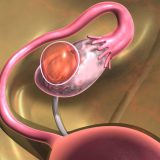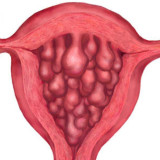Vaginal cysts are an abnormality that most often results from sexually transmitted infections and for many other reasons. Very often, this formation develops without any symptoms and is discovered by chance during the routine examination by a gynecologist. Today, find out what are the symptoms of this disease, its methods of treatment and prevention.
What are vaginal cysts?
Vaginal cysts are benign cystic formations, the causes of which can be different, but often they develop as a result of poor-quality treatment of infectious diseases. Cysts often concentrate on the side of the vagina. They are round or oval in shape, they are tight and elastic to the touch. Cystic formation can reach the size of a chicken egg. The most common vaginal cysts are detected by visual gynecological examination. This pathology is diagnosed in 2% of women of childbearing age.
Causes of cystic formation
A vaginal cyst may appear:
- With congenital malformations of the vagina;
- In the event of injury that may lead to the formation of hematomas in the vagina;
- Once a patient had an abortion;
- When infections are transmitted sexually (gonorrhea, chlamydia, trichomoniasis);
- As a result of neglect of personal hygiene;
- In chronic infectious and inflammatory processes in the vagina.
These symptoms may not appear immediately. Vaginal cystic formations are an insidious disease that may not manifest for a long time.
Disease Recognition
If you suspect a pathology gynecologist assigns the following types of research:
- Colposcopy – examination of the vagina, its walls and cervix using a special device – binoculars with a light element;
- Bacteriological examination;
- Microscopic analysis.
For an accurate diagnosis of the disease, it is advisable to undergo additional consultations with an gynecologist.
How is the treatment of vaginal cysts?
Treatment for vaginal cysts can have two options:
- Surgical method of getting rid of the disease;
- Treatment with traditional medicine (effectiveness is not proven).
If the education is small and yet the woman is not bothered, doctors often do not raise the issue of removing the tumor. It is enough that this happens periodically and to go to a consultation with a doctor so that he control the formation.
If the cyst has clinical signs or grows in size, only one therapy is effective – an operation that can be performed in four ways.
You can also slow down the growth of a cyst with the help of traditional methods of treatment: decoctions of herbs or ointment. But you should remember that these tools will not help completely get rid of a vaginal cyst.
Types of cystic formation removal operations
- The absorption of fluid inside the cyst. Removal of a vaginal cyst by this method gives a temporary effect, and this is all because cells produced by special epithelial cells continue to collect the contents. This type of therapy is used by the doctor only for pregnant women and only if the education is large and it covers the birth canal.
- Marsupalization. This method of getting rid of the disease is the most gentle and safe. The cyst is dissected, the contents are emptied, and then the walls of the formation fall on the vaginal mucosa, which prevents re-development.
- Complete removal. This method is used when there is a congenital or deep cystic formation. In this case, the wall is cut by a longitudinal incision, the cyst is removed and closed with sutures.
- If it is impossible to eliminate benign lesions through the vagina without complications, the doctor may prescribe a laparotomy. In this case, an incision is made in the abdominal wall and open access to remove the cyst.
Preparation for surgery
For any intervention, you must undergo a diagnostic examination, which is a collection of tests and ultrasound of the female genital organs. After confirming the diagnosis of vaginal cysts, the gynecologist will determine whether to prepare the patient for surgery (if the cyst is large and causes excitement in the woman) or not. Removal of a cyst takes place under general anesthesia, so the doctor before the event, personally ensures that patients do not have contraindications to the use of anesthetic. Also, before the operation, the patient is consulted by an anesthesiologist.
Recovery after surgery
The rehabilitation period passes quickly. The woman is in the hospital or on an outpatient basis, she is constantly monitored by a doctor. After surgery, after some time, patients can become pregnant and give birth without problems. Menstruation in a woman returns to normal within a month after surgery.
Prevention
In order to never have a vaginal cyst, it is important to take preventive measures, which are expressed in the following points:
- Necessary to monitor the hygiene of the genitals;
- It is impossible to prevent hypothermia;
- To be examined by a gynecologist at least 2 times a year;
- It is necessary to treat infectious and inflammatory diseases in a timely manner;
- very important to engage in physical education and sports;
- In order to avoid the appearance of cysts in the vagina, the organization of proper nutrition and daily routines will also help;
- Random sex is not allowed;
- We need to quit smoking and excessive drinking.











